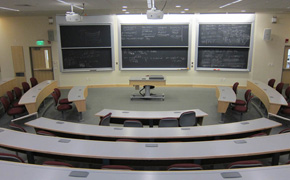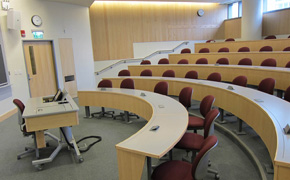Instructor Insights pages are part of the OCW Educator initiative, which seeks to enhance the value of OCW for educators.
Course Overview
This page focuses on the course 15.872 Introduction to System Dynamics as it was taught by John Sterman and Hazhir Rahmandad in Fall 2013.
15.872 System Dynamics II is the second half-semester continuation of 15.871 Introduction to System Dynamics. Students can take 15.871 alone, or combine it with 15.872. Taken in sequence the courses constitute the introductory sequence in system dynamics. Successful completion of both 15.871 and 15.872 is a prerequisite for advanced courses in system dynamics, work as a research or teaching assistant in the field, or careers using system dynamics.
During this second half of the semester, 2 class sections were taught by John Sterman and Hazhir Rahmandad. Sloan Fellows wishing to complete the course sequence were combined into these sections.
Professor Sterman gives an introduction to system dynamics and an overview of the course sequence in this video.
Course Outcomes
Course Goals for Students
15.871 and 15.872 introduce students to system dynamics modeling for the analysis of business policy and strategy. Students will learn to visualize a business organization in terms of the structures and policies that create dynamics and regulate performance. The class uses simulation models, case studies, and management flight simulators to develop principles of policy design for successful management of complex strategies, and to improve our understanding of the ways in which an organization’s performance is related to its internal structure and operating policies as well as those of customers, competitors, suppliers, and other stakeholders.
Curriculum Information
Prerequisites
15.871 Introduction to System Dynamics
Requirements Satisfied
H-Level Graduate Credit ![]() https://ocwcms.mit.edu/courses/sloan-school-of-management/15-871-introduction-to-system-dynamics-fall-2013/this-course-at-mit/preview
https://ocwcms.mit.edu/courses/sloan-school-of-management/15-871-introduction-to-system-dynamics-fall-2013/this-course-at-mit/preview
Offered
Every fall and spring semester
Assessment
The students' grades were based on the following assessment elements:
 70% Assignments
70% Assignments 15% Class participation
15% Class participation 15% Peer evaluation
15% Peer evaluationStudent Information

Enrollment
A total of about 120 students were split among 2 sections for this course.
Breakdown by Year
Mostly graduate students, a few undergrads.
Breakdown by Major
Mostly Sloan MBAs and Sloan Fellows, some LGOs, students from the Master of Science in Management Studies (MSMS) and PhD programs, and a few students from Harvard Kennedy and other local schools.
During an average week, students were expected to spend 7-10 hours on the course, roughly divided as follows:
In Class
- Course met 2 times per week for 90 minutes per session; mandatory attendance.
- Recitation for review, where TAs fielded questions about the materials; optional attendance.
Out of Class
- Weekly readings in preparation for class
- Five assignments making use of modeling software
Semester Breakdown
This half-term course ran during the second half of the fall semester.
| WEEK | M | T | W | Th | F |
|---|---|---|---|---|---|
| 1 |  |  |  |  |  |
| 2 |  |  |  |  |  |
| 3 |  |  |  |  |  |
| 4 |  |  |  |  |  |
| 5 |  |  |  |  |  |
| 6 |  |  |  |  |  |
| 7 |  |  |  |  |  |
| 8 |  |  |  |  |  |
| 9 |  |  |  |  |  |
| 10 |  |  |  |  |  |
| 11 |  |  |  |  |  |
| 12 |  |  |  |  |  |
| 13 |  |  |  |  |  |
| 14 |  |  |  |  |  |
| 15 |  |  |  |  |  |
| 16 |  |  |  |  |  |
 No classes throughout MIT
No classes throughout MIT Lecture session
Lecture session Assignment due date
Assignment due date No class session scheduled
No class session scheduled Recitation session
Recitation session

 Room 1 of 2
Room 1 of 2 
